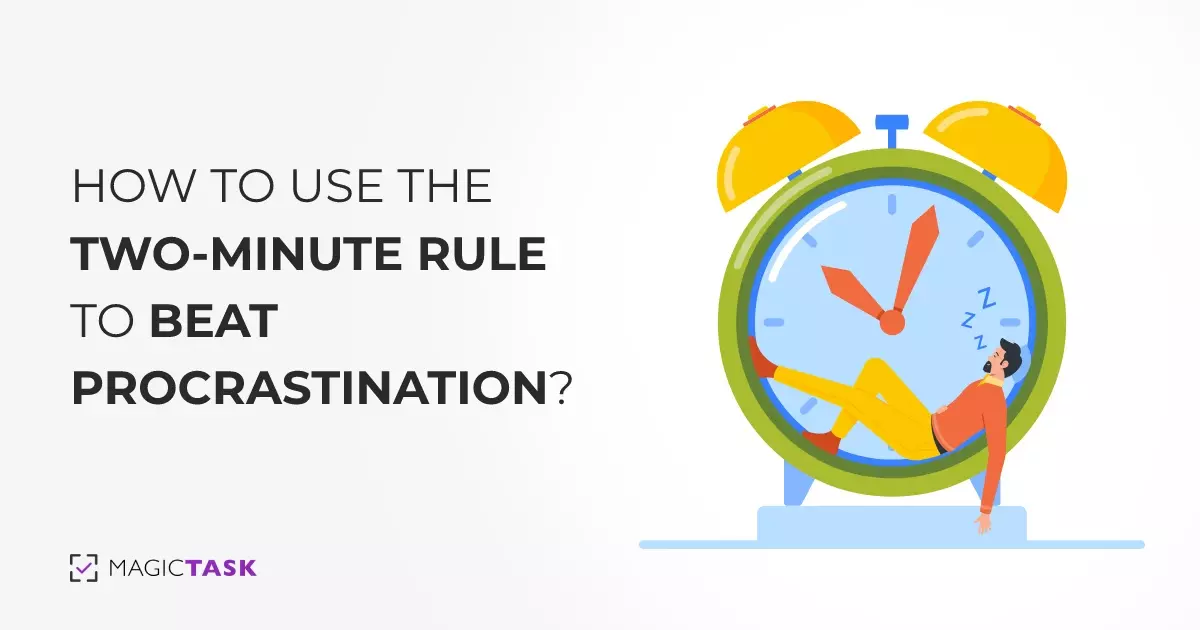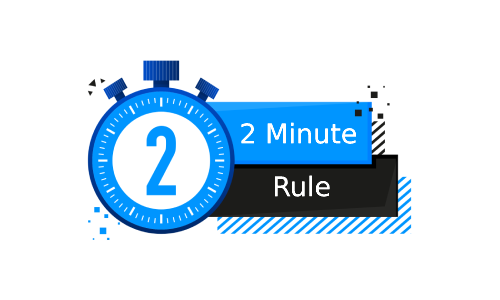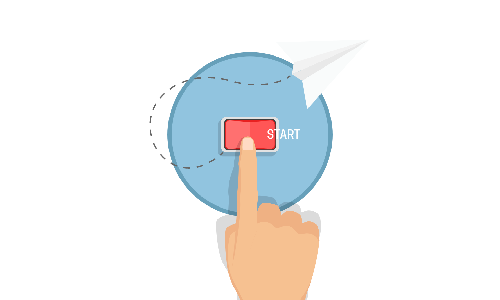How to Use the Two-Minute Rule To Beat Procrastination

Procrastination is your worst enemy when you're trying to be more productive and get more things done. It's like the static friction we must all overcome before we start doing something.
Frequent procrastination can make us habitually late or delay our projects. It can make our life more stressful as we try to reach our goals in a shorter time.
With procrastination, we are our own worst enemies. So how can we procrastinate less? How can we motivate ourselves to get up and start doing what we've postponed?
This is where the two-minute rule can help you.
What is The 2-Minute Rule?
Procrastination is like the static force of friction that keeps us from moving a large box on the ground. Once we get the box moving, we can see that we need much less force to keep doing that. But it takes much more force to get it moving when it is resting.
Similarly, once we start doing the task, we can finish it easily; but just getting started on it often looks like a massive boulder in our path.
The two-minute rule can help us overcome this initial difficulty and avoid procrastination. David Allen introduced this concept for the first time in his book 'Getting Things Done.' The rule is designed to make it easy to build new habits.
The approach understands procrastination usually stems from the size of a task or the time it may take to finish it. For example, if we have a load of laundry to take care of, we may look at our dirty clothes, estimate that it may take an hour or so, and become afraid to commit that much time. Or sometimes, we spend way too much time thinking about it and not doing it.

The two-minute rule also explains how we often plan our tasks and assign time, even for small things in our life, to avoid doing them. We end up piling up even small tasks like responding to an email or making an appointment until we just can't handle the stress of not doing it.
It is part of the Getting Things Done method, a popular productivity strategy. The GTD method is an attempt to reduce our cognitive load and focus on a task at a time while making us focus on our long-term goals.
Since its introduction, the two-minute rule has become very popular among CEOs and entrepreneurs. There are many famous figures who constantly try to supercharge their productivity using the rule. The approach has been featured in Forbes, CNBC, Business Insider, and many other news outlets.
Advantages of the 2-Minute Rule
Below we have enlisted some key advantages of the 2-minute rule:
1. It helps you avoid procrastination.
Many productivity techniques and methods help you plan out and get the maximum number of tasks done in a day. But these methods will only work if you do the tasks you've planned. In fact, the sheer number of tasks can cause you to freeze up and procrastinate further.
The 2-minute rule helps you tackle the tasks one after another without procrastinating. It enables you to break down your tasks into small pieces that add up together and check them off your to-do list. The approach is particularly great for the tasks that take little time but those you keep putting off.
2. It's simple and easy to implement
Most productivity techniques involve a lot of effort from your end. For instance, the Getting Things Done method requires you to write down all of your tasks, sort them based on different criteria, use multiple tools, and plan out how you'll tackle the various tasks. With the Pomodoro Technique, you have to list your tasks, set timers, and stick to a schedule.
These productivity methods help you achieve your goals and complete your tasks in the shortest time. But they all require considerable effort from your end. But the 2-minute rule is simple and hardly takes any time or resources to implement. You can be sure that you won't procrastinate on your productivity method.
3. It helps you build long-lasting habits.
To achieve long-term goals, you need to identify the tasks that contribute to them and make them a habit. For instance, if you want to finish a marathon the following year, you'll have to work out daily and build your stamina.
But we all know how we're way too excited when starting but soon lose interest and quit before achieving our goals. This is why gym memberships often skyrocket every new year, but members stop coming soon after.
When the results are not immediate, it isn't easy to stay on track. The 2-minute rule can help you stay on course by giving us small wins throughout the way.
4. It helps you get started.

The most challenging part of completing a task is to get started, particularly when the task is time-consuming. Just like pushing a boulder, it becomes easier to take it to the finish line once we get going.
But often, we look at the tasks, consider the time and just put it off for later. Sometimes we do it even for the most minor tasks, such as writing down the grocery list.
The two-minute rule reduces the force we need to move the boulder. Instead of staring down an enormous task, we take care of a small part of it and then move on to the next once we get the ball rolling.
5. The approach demands the least effort from you.
The two-minute rule doesn't demand that you work at a specific time or follow a set of steps to finish your tasks. It doesn't need you to invest in productivity tools or equipment. The two-minute rule is designed to free you of the stress from the tasks you're pushing ahead.
The approach helps you finish your task on time without stressing you out. This is not something a lot of productivity techniques can claim. Some productivity techniques, while helping you manage more tasks, often require a lot of effort. The two-minute rule requires the least from you and offers you a lot.
How Does 2-Minute Rule Work?
There are two ways you can look at the two-minute rule.
First approach:
The first is that if you have a task that takes less than two minutes, do it the moment you define it. This part fits into Getting Things Done method. Within GTD, you have to either do, delegate, or defer your tasks. The two-minute rule is related to the 'do' aspect of it.
When you start, write down the list of tasks you must do. Of these, pick the tasks that will take you less than two minutes. And do it just then instead of setting aside time for it or planning it further. Of course, if you need assistance from someone else on the task, you can delegate it.
The theme behind this approach is that the time spent planning a task that takes less than two minutes is time you shouldn't be wasting. Or simply put, don't plan tasks that don't need planning, but rather just finish them.
For instance, don't set aside time to make a short phone call or reply to just one email. When you get the task, finish it off instead of setting reminders or adding it to your to-do list.
Second approach:
The second way to look at the two-minute rule is to take a large goal that will take a lot of time and energy and make it small.
For instance, imagine you've set a goal to write five pages of a book before you go to bed. This is a rather large goal and will take significant time and effort on your part to achieve. Instead of this, set a smaller goal that will take you just 2 minutes to complete. Maybe you can write just one paragraph before you go to bed every night, or you can write a general outline for the page.
Instead of doing an enormous task, you can take the first step, which will take you just two minutes. For instance, imagine you want to start painting 30 minutes a day from the next day onwards. Instead, for the next day, you can just ensure you check if you have all the equipment. If you don't, the next day you can just make sure you decide what you'll need.
It may look like you're not doing anything at a glance. But the fact is we often overestimate what we can do in a day and underestimate what we can do in a year.
Many people decide on their birthdays or New Years' eve that they'll start spending an hour in the gym or quit smoking from the next day onwards. They may try hard for the next two weeks or stick to this, but they most likely won't be able to. And when they fail to achieve this goal one day, they'll drop the plan altogether instead of trying to accomplish it the next day.
It's like telling yourself that you'd deadlift 75 kgs the day you start going to the gym. Instead of setting unattainable goals, set a very small goal, achieve it, and ride on that success all the way to the top.
If you find it difficult to form a habit, set ridiculously small goals for yourself and stick to them for a while. Don't try to climb Everest on the first day; just putting on your boots is enough for day one.
Supercharge Your Productivity and Overcome Your Procrastination With the Two-minute Rule
The two-minute rule is one of the very few productivities hacks you can implement right now. You can use plenty of tools, but you really don't need them for the two-minute rule.
If you want, you can list your tasks to figure out, which will take two minutes. Once you have the list, go through them and just check them off one by one.




